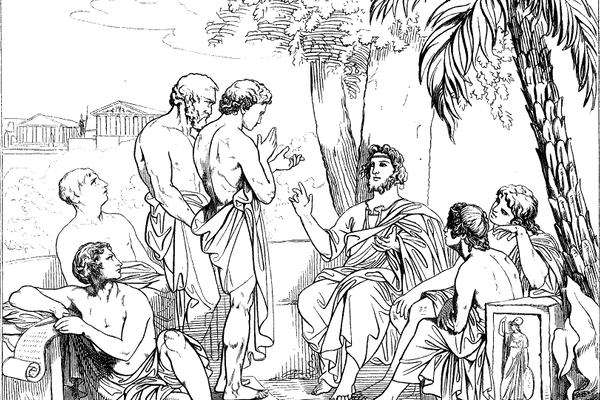Collegiality, Interdisciplinarity, and the Historian's Work

Plato's Academy, after Carl Johan Wahlbom
At many universities, scholars are encouraged to be “interdisciplinary,” in the classroom and in their work. Some scholars desire to do interdisciplinary research or create work that speaks across disciplines. However, most PhDs spent most of the time earning that degree in a single discipline. And once out in the world, they are often housed in single-discipline departments. None of that precludes interdisciplinary work, but it does mean that regularly engaging with scholars and work from other disciplines is not automatic. Collegiality can help bridge the gap.
At my university, every summer we have a colloquium series for interested faculty put together by the Honors Program. There are three books, mostly from the Honors curriculum or adjacent to it, which we read and discuss in a Socratic format. All of the faculty are invited and can read all three books or any one of them. Not all of the faculty participate, but every summer we have engaged participants from a variety of disciplines. This summer during a session on St. Augustine’s On Doctrine, we were discussing semiotics with people from history, pharmacy, communication, computer science, and dance, among others.
The biggest immediate effect of this series is collegiality. People from very different parts of the university get to know each other and become more comfortable with each other. We learn the names that go with faces and we learn the specific skillsets that people bring to campus. And we learn to work together better—we practice collegiality. When you undertake to read and understand a book together, you are engaging in shared learning, but also something of a shared project. A book like Frankenstein may seem fairly easy to approach, but not all of us come to the table with interests or backgrounds prepped for Schiller’s On Aesthetic Education or MacIntyre’s After Virtue or Hofstadter’s Anti-Intellectualism in American Life. And we soon learn how differently disciplines can approach texts and questions. And how beautiful that can be.
If collegiality is the immediate outcome of the colloquium series, it is not the only outcome. As faculty become more comfortable with each other, they become more familiar with the tools and approaches other disciplines use. As it happens, sitting with someone who operates differently is an excellent starting point for learning from them or working with them. The colloquium series has prompted interdisciplinary collaboration and has continued education for all of us.
Even in settings that are explicitly interdisciplinary or intended to have productive outcomes, collegiality smooths the way. This summer I was fortunate to participate in an NEH Institute, “The Revolution in Books” at Florida Atlantic University. We learned about the role of books and printing in the American Revolution, learned about books as objects, and we also got to make and marble paper, set type, and stitch bindings. It was a great experience, enhanced by FAU’s resources, like the Jaffe Center for Book Arts and the Weiner Spirit of America Collection with its excellent sources. But our experience was made even better by the variety among participants.
The NEH Institute brought together all kinds of scholars and artists for “The Revolution in Books.” We had academics who focused on literature and history, librarians and archivists, and even artists. We had people familiar with the names of colonial America loyalists, people who knew pirate songs, and people who could recognize all kinds of typefaces. In sessions, we learned what different disciplines had to offer for approaching subjects. And as we got to know each other better, we also talked more outside of sessions about approaches to learning and teaching. A lunch or a dinner could be a launching point for a new project or an introduction to new pedagogy.
The NEH Institute was designed for just this kind of outcome. Participants are intentionally drawn from different disciplinary backgrounds. And the hands-on sessions put people together to work on projects. Most participants stay on campus. It builds camaraderie and collegiality. By the end of our time together, everyone had learned about new techniques for art and books, or new tools for teaching, or new resources for research. Each participant has a final project and it’s fair to say that all of them have benefited in some way from the span of interests and approaches that were in the group. (Those projects will be presented on a public Zoom, August 4 & 5.)
The best interdisciplinary collaborations come about when people aren’t just looking to “do interdisciplinary work,” but when we have regular interdisciplinary interactions. Conversations can lead to collaboration in very natural ways. If we want our departments or universities to see and do more outside disciplinary boundaries, we need to create environments for more engagement with others. Opportunities that involve working together to create something or understanding something are optimal. Collegiality is a strong foundation for interdisciplinary work and thought.